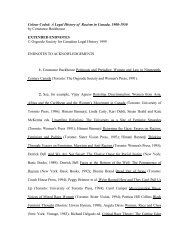Spring/Summer 2005 - University of Toronto Press Publishing
Spring/Summer 2005 - University of Toronto Press Publishing
Spring/Summer 2005 - University of Toronto Press Publishing
Create successful ePaper yourself
Turn your PDF publications into a flip-book with our unique Google optimized e-Paper software.
GENERAL INTERESTLiving in the Labyrinth <strong>of</strong> TechnologyWillem H. VanderburgFrom the very beginnings <strong>of</strong> their existence, humanbeings have distinguished themselves from otheranimals by not taking immediate experience forgranted. Everything was symbolized according to itsmeaning and value: a fallen branch from a treebecame a lever; a tree trunk floating in the riverbecame a canoe. Homo logos created communitiesbased on cultures: humanity’s first megaproject.Further symbolization <strong>of</strong> the human communityand its relation to nature led to the possibility<strong>of</strong> creating societies and civilizations. Everythingchanged as these interposed themselves between thegroup and nature. Homo societas created ways <strong>of</strong> lifeable to give meaning, direction, and purpose tomany groups by means <strong>of</strong> very different cultures:humanity’s second megaproject.What Das Kapital did for the nineteenth centuryand La technique did for the twentieth, WillemH. Vanderburg’s Living in the Labyrinth <strong>of</strong>Technology seeks to create for the twenty-first century:an attempt at understanding the world in a mannernot shackled to overspecialized scientific knowingand technical doing. Western civilization maywell be creating humanity’s third megaproject, basednot on symbolization for making sense <strong>of</strong> and livingin the world, but on highly specialized desymbolizedknowing stripped <strong>of</strong> all peripheral understanding.Vanderburg focuses on two interdependentforces in his narrative, namely, people changingtechnology and technology changing people. Thelatter aspect, although rarely considered, turns outto be the more critical one for understanding thespectacular successes and failures <strong>of</strong> contemporaryways <strong>of</strong> life. As technology continues to change thesocial and physical world, the experiences <strong>of</strong> thisworld ‘grow’ people’s minds and society’s cultures,thereby re-creating human life in the image <strong>of</strong> technology.Living in the Labyrinth <strong>of</strong> Technology arguesthat the twenty-first century will be dominated bythis pattern unless society intervenes on human (asopposed to technical) terms.Willem H. Vanderburg is the director <strong>of</strong> the Centre forTechnology and Social Development and a pr<strong>of</strong>essorin the Department <strong>of</strong> Civil Engineering, the Institutefor Environmental Studies, and the Department <strong>of</strong>Sociology at the <strong>University</strong> <strong>of</strong> <strong>Toronto</strong>.‘Willem H. Vanderburg’s work is highly regarded by many,but Living in the Labyrinth <strong>of</strong> Technology is surely hismost important book. Vanderburg compellingly explainshow daily life in modern society has evolved to become routinelyblind to the forces <strong>of</strong> authoritarianism and conformity.We learn, painfully, not only how the everyday <strong>of</strong> modernlife fails to question the meaning or ethics <strong>of</strong> its constructedreality, but why. The book’s disturbing explanation cannotcomfort readers, but it does <strong>of</strong>fer the chance to reflect on ourcultural drift and, just possibly, to realize the need to resurrectnormative purposes for our being. A major work.’John Byrne, Center for Energy and EnvironmentalPolicy, <strong>University</strong> <strong>of</strong> Delaware‘An important contribution to the ongoing debate aboutwhere current events are leading us, Living in the Labyrinth<strong>of</strong> Technology is dense with pr<strong>of</strong>ound, disturbing, and <strong>of</strong>tensurprising insights and connections. Vanderburg’s writing isexcellent – clear and refreshingly conversational – and heperforms an important role in pulling together Jacques Ellul’sideas about technology and technique and updating Ellul’sconclusions to the present at a time when the downside <strong>of</strong>technique seems to be accelerating.’Stuart Dreyfus, College <strong>of</strong> Engineering, <strong>University</strong> <strong>of</strong>California, BerkeleyAlso by Willem H. Vanderburg:The Labyrinth <strong>of</strong> TechnologyA Preventive Technology and Economic Strategyas a Way Out0-8020-8385-4 / £16.00 / $28.95 / 2000SOCIOLOGY / TECHNOLOGYApprox. 550 pp / 6 x 9 / May <strong>2005</strong>Cloth ISBN 0-8020-4432-8 £48.00 $75.00 EPaper ISBN 0-8020-4879-X £22.50 $35.00 C12
















